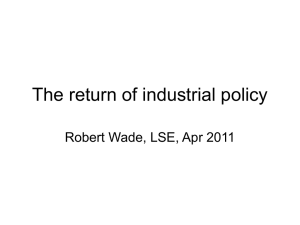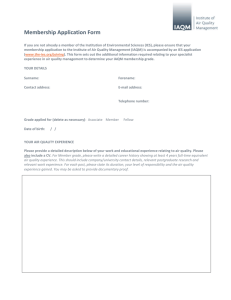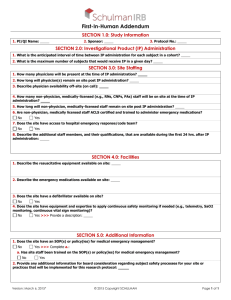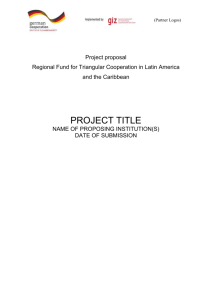factsheet 3 - clean air institute
advertisement
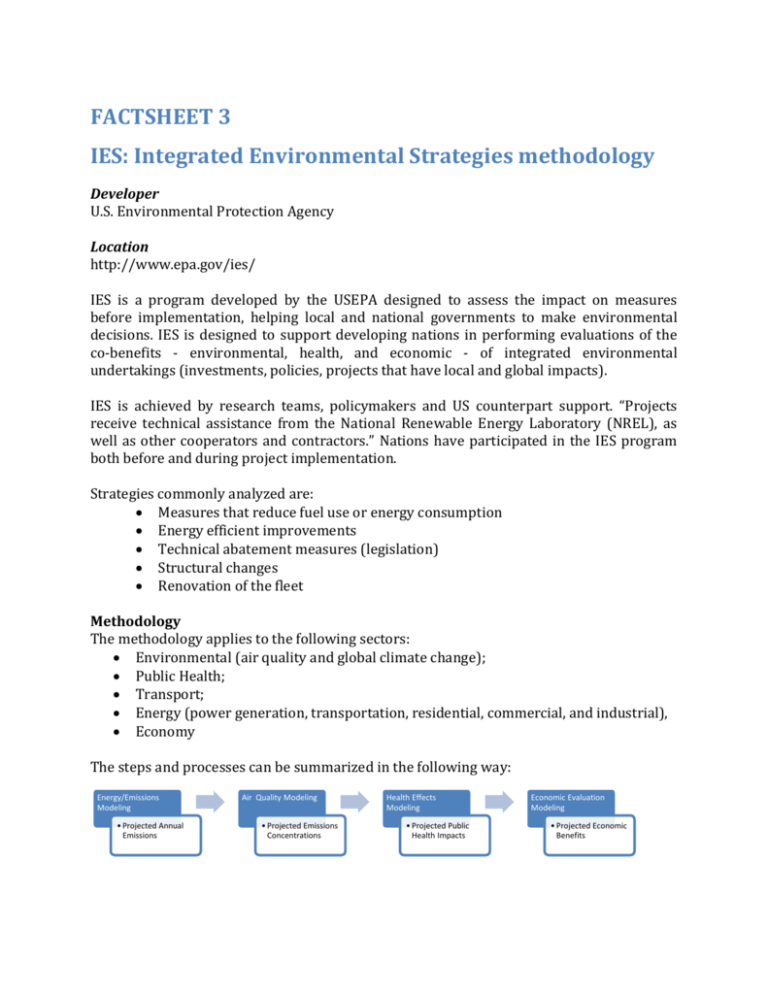
FACTSHEET 3 IES: Integrated Environmental Strategies methodology Developer U.S. Environmental Protection Agency Location http://www.epa.gov/ies/ IES is a program developed by the USEPA designed to assess the impact on measures before implementation, helping local and national governments to make environmental decisions. IES is designed to support developing nations in performing evaluations of the co-benefits - environmental, health, and economic - of integrated environmental undertakings (investments, policies, projects that have local and global impacts). IES is achieved by research teams, policymakers and US counterpart support. “Projects receive technical assistance from the National Renewable Energy Laboratory (NREL), as well as other cooperators and contractors.” Nations have participated in the IES program both before and during project implementation. Strategies commonly analyzed are: Measures that reduce fuel use or energy consumption Energy efficient improvements Technical abatement measures (legislation) Structural changes Renovation of the fleet Methodology The methodology applies to the following sectors: Environmental (air quality and global climate change); Public Health; Transport; Energy (power generation, transportation, residential, commercial, and industrial), Economy The steps and processes can be summarized in the following way: Energy/Emissions Modeling • Projected Annual Emissions Air Quality Modeling • Projected Emissions Concentrations Health Effects Modeling • Projected Public Health Impacts Economic Evaluation Modeling • Projected Economic Benefits Scope project and build the team Air pollutant and GHG emissions analysis Optimization - IES - Scenarios (Develop energy/transport emissions baseline and scenarios) Air quality modeling (calculate atmospheric concentrations) Health effect analysis (quantify public health effects) Perform economic valuation of health benefits Prioritize measures and share results Implement measure Table 4.1 summarizes the models commonly used to complete each of the steps outlined above. Table 4.1 Models commonly used in the IES Energy/Emissions Bottom-up: MARKAL - Market allocation model EPA's MOBILE 6 LEAP - The Long-range Energy Alternatives Planning model Energy and Power Evaluation Program Model for Analysis of Energy Demand (ENPEP-MAED) Top-down: CGE: The computable general equilibrium model Air Quality SofIA-Software de Impacto Atmosferico Box Mode Source Apportionment Method ATMOS/UR-BAT (Urban Branching Atmospheric Trajectory) Model California Institute of Technology (CIT) Model, Models-3/ Community Multiscale Air Quality (CMAQ) Model Industrial Source Complex 3 (ISC3) Model Gaussian Plume Model (custom) Urban Air Model (UAM). Health Effects APHEBA – The Air Pollution Health Effects Benefit Analysis. BenMAP-Int – The Environmental Benefits Mapping and Analysis ProgramInternational. Economy Evaluation EPA - Guidelines for preparing Economy Analyses For Health Effects: WTP Methods Pollutants/Gases commonly analyzed Table 4.2 IES Pollutants/Gases commonly analyzed Conventional* CO: Carbon Monoxide VOC: Volatile Organic Compounds NOx: Nitrogen Oxides SO2: -Sulfur Dioxide PM: Particulate Matter (PM10 and PM2.5) Green house gases CO2: Carbon Dioxide N2O: Nitrous Oxide CH4: Methane Other pollutants Hg: Mercury Pb: Lead HFCs: Hydroflurocarbons PFCs: Perfluorocarbons * Defined as air pollutants in any country that can cause human health impacts. Evaluation Table 4.3 IES Evaluation (strengths and weaknesses) Strengths Weaknesses One of few methodologies that includes an Requires wide-scale national involvement, integrated assessment of health and which might slow project progress; project economic impacts of environmental projects teams typically involve professionals from multiple universities, private consultancies, IES is specifically targeted to developing and government agencies. nations in contrast to THE PEP1 Projects are large-scale, assessing numerous Unlike THE PEP, IES projects often include measures that are often highly capitalnon-transport components intensive IES results may be used to apply for funding from other programs (e.g. IES results supported Chile’s successful application to receive GEF funding) Precedents Government agencies and research institutions in Argentina, Brazil, China, Chile, South Korea, India, the Philippines, and Mexico participate in the IES program. Most Recently Colombia is working in IES – Bogota. IES Studies made in different Latin America cities is presented in the table 4.4 below. Table 4.4 IES Latin America Studies 1 THE PEP is a methodology focused on approaches to the economic valuation of potential health effects. The result is meant primarily for integration into comprehensive cost-benefit analyses of transport interventions or infrastructure projects, but can also serve for an assessment of the current situation or of investments made in the past. Location Brazil (Sao Paulo) Argentina (Buenos Aires) Chile (Santiago ) Mexico (Mexico City) Year Initiate d 1998 2000 2000 2002 Transit Scenarios Considered Increase in vehicular ethanol use Substitution of existing diesel buses with hybrid dieselelectric and natural gas buses Implementation of an I/M program Improvement of the public transport system "Adoption of emissions control devices by heavy-duty diesel vehicles" Mitigation Scenario: Increased use of compressed natural gas Changes in relative pricing of fuels Incentives to improve vehicle efficiency Integrated Scenario (in addition to the CNG scenario): Expansion of subway system Traffic mitigation through tax incentives, traffic reengineering, promotion of public transit Speed limits and controls via radars and cameras Replace diesel buses with CNGfueled buses Replace existing diesel buses with hybrid diesel-electric buses Renovate taxi fleet Implement congestion taxes Phase 2: Renovation of taxi fleet Expansion of the metro system Integration of hybrid buses into the bus fleet Phase 3: quantification of costs/benefits of Metrobus BRT system Health Effects Considered Models Used PM10, sulfur dioxide, carbon monoxide, nitrogen oxides, volatile organic compounds, ozone, CO2, methane Morbidity and mortality levels for individuals of all age levels Energy and emissions inventory: LongRange Energy Alternatives Planning (LEAP) system, California Institute of Technology Model NOx, PM, CO2 Premature mortality, rate of hospitalizati on/ER visits for respiratory diseases Software de Impacto Atmosferica (SofIA) Gases/Pollutants Considered PM2.5, PM10, CO, Ozone, SO2, SOx, NOx, VOC Phase 2: PM2.5, PM10, O3, CO2, CH4, N2O Phase 3: PM2.5, NOx, SO2, total hydrocarbons, CO2, CH3, N2O Premature mortality, rate of hospitalizati on/ER visits for respiratory diseases Phase 2: Qualityadjusted life years Phase 3: work loss days, restricted activity days, number of cases of Air Pollution Health Effects Benefits Assessment (APHEBA) valuation model, ESTRAUS, MODEM, VERDI, Emissions Inventory Management System (SAIE), AIRVIRO, CAPMS, MODEC, CAMx, box model, source apportionment method Phase 2: Analytica software CoBenefits Model, Multiscale Climate Chemistry Model, MOBILE5MCMA, CAM's MCCM model, locally chronic bronchitis, premature mortality Colombia (Bogota) 2011 Optimizar el Sistema Integrado de Transporte Público. Three sceneries: Without Integrated public transport system IPTS, with IPTS and IPTS environmental emphasis. Exposure level perspective. PM10 and CO2 Mortality, and ER visits for respiratory diseases developed box model, , California Institute of Technology model Phase 3: MOBILE6MEXICO The Transport Emission Model for Line Sources (TREM) and the Local Scale Dispersion Model (VADIS). Vehicle Specific Power (VSP) Software system for transportation planningVelocity –VISUM adapted for Bogota. Source: (Summary – IES USEPA) References Fitzgerald, J., 2010. Integrated Environmental Strategies Program Presentation. Climate Change Division, US. EPA. Bogota, Colombia. Chae, Y., 2010. Co-benefit analysis of an air quality management plan and greenhouse gas reduction strategies in the Seoul metropolitan area. Environmental Science and Policy 13. Pages 205-216. Chae Y., and Park J., 2011. Quantifying costs and benefits of integrated environmental strategies of air quality management and greenhouse gas reduction in the Seoul Metropolitan Area. Energy Policy. Pages 1-13. Budh E., 2007. Can integrated control strategies for multiple emissions enhance cost-efficiency in environmental policy? Evidence from Sweden. Environmental Science and Policy 10. Pages 104-115.



